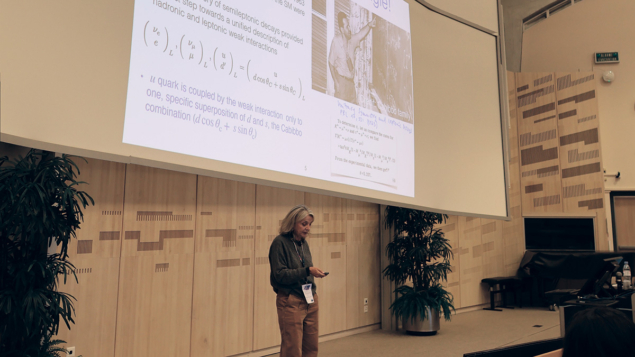
The 13th annual “Implications of LHCb measurements and future prospects” workshop, held at CERN on 25–27 October 2023, drew substantial interest with 231 participants. This collaborative event between LHCb and the theoretical community showcased the mutual enthusiasm for LHCb’s physics advances. The workshop featured five streams highlighting the latest experimental and theoretical developments in mixing and CP violation, heavy ions and fixed-target results, flavour-changing charged currents, QCD spectroscopy and exotics, and flavour-changing neutral currents.
The opening talk by Monica Pepe Altarelli underscored LHCb’s diverse physics programme, solidifying its role as a highly versatile forward detector. While celebrating successes, her talk candidly addressed setbacks, notably the new results in tests of lepton-flavour universality. LHCb detector and computing upgrades for Run 3 include a fully software-based trigger using graphics processing units. The collaboration is also working towards an Upgrade II programme for Long Shutdown 4 (2033–2034) that would position LHCb as a potentially unique global flavour facility.
On mixing and CP violation, the October workshop unveiled intriguing insights in both the beauty and charm sectors. In the beauty sector, notable highlights encompass measurements of the mixing parameter ΔΓs and of CP-violating phases such as ϕs,d, ϕssss and γ. CP asymmetries were further scrutinised in B → DD decays, accounting for SU(3) breaking and re-scattering effects. In the charm sector, the estimated CP asymmetries considering final-state interactions were found to be small compared to the experimental values related to D0 → π–π+ and D0 → K–K+ decays. Novel measurements of CP violation in three-body charm hadron decays were also presented.
Unique capabilities
On the theoretical front, discussions delved into the current status of bottom-baryon lifetimes. Recent lattice predictions on the εK parameter were also showcased, offering refined constraints on the unitarity triangle. The LHCb experiment’s unique capabilities were discussed in the heavy ions and fixed-target session. Operating in fixed-target mode, LHCb collected data pertaining to proton–ion and lead–ion interactions during LHC Run 2 using the SMOG system. Key highlights included measurements impacting theoretical models of charm hadronisation, global analyses of nuclear parton density functions, and the identification of helium nuclei and deuterons. The first Run 3 data with the SMOG2 upgrade showed promising results in proton–argon and proton–hydrogen collisions, opening a path to measurements with implications for heavy-ion physics and astrophysics.
The session on flavour-changing charged currents unveiled a recent measurement concerning the longitudinal polarisation of D*− mesons in B0 → D*−τ–ντ decays, aligning with Standard Model (SM) expectations. Discussions delved into lepton-flavour-universality tests that showed a 3.3σ tension with predictions in the combined R(D(*)) measurement. Noteworthy were new lattice-QCD predictions for charged current decays, especially R(D(*)), showcasing disparities in the SM prediction across different lattice groups. Updates on the CKM matrix elements |Vub| and |Vcb| lead to a reduced tension between inclusive and exclusive determinations. The session also discussed the impact of high-energy constraints of Wilson coefficients on charged-current decays and Bayesian inference of form-factor parameters, regulated by unitarity and analyticity. The QCD spectroscopy and exotics session also featured important findings, including the discovery of novel baryon states, notably Ξb(6087)0 and Ξb(6095)0. Pentaquark exploration involved diverse charm–hadron combinations, alongside precision measurements of the Ω0c mass and first observations of b-hadron decays with potential exotic-state contributions. Charmonia-associated production provided fresh insights for testing QCD predictions, and an approach based on effective field theory (EFT) interpreting pentaquarks as hadronic molecules was presented. A new model-independent Born–Oppenheimer EFT framework for the interpretation of doubly heavy tetraquarks, utilising lattice QCD predictions, was introduced. Scrutinising charm–tetraquark decays and the interpretation of newly discovered hadron states at the LHC were also discussed.
During the flavour-changing neutral-current session a new analysis of B0 → K*0μ+μ– decays was presented, showing consistency with SM expectations. Stringent limits on branching fractions of rare charm decays and precise differential branching fraction measurements of b-baryon decays were also highlighted. Challenges in SM predictions for b → sℓℓ and rare charm decays were discussed, underscoring the imperative for a deeper comprehension of underlying hadronic processes, particularly leveraging LHCb data. Global analyses of b → dℓℓ and b → sℓℓ decays were presented, alongside future prospects for these decays in Run 3 and beyond. The session also explored strategies to enhance sensitivity to new physics in B± → π±μ+μ– decays.
The keynote talk, delivered by Svjetlana Fajfer, offered a comprehensive summary and highlighted existing anomalies that demand further consideration. Tackling these challenges necessitates precise measurements at both low and high energies, with the collaborative efforts of LHCb, Belle II, CMS and ATLAS. Additionally, advancements in lattice QCD and other novel theoretical approaches are needed for precise theoretical predictions in tandem with experimental efforts.








